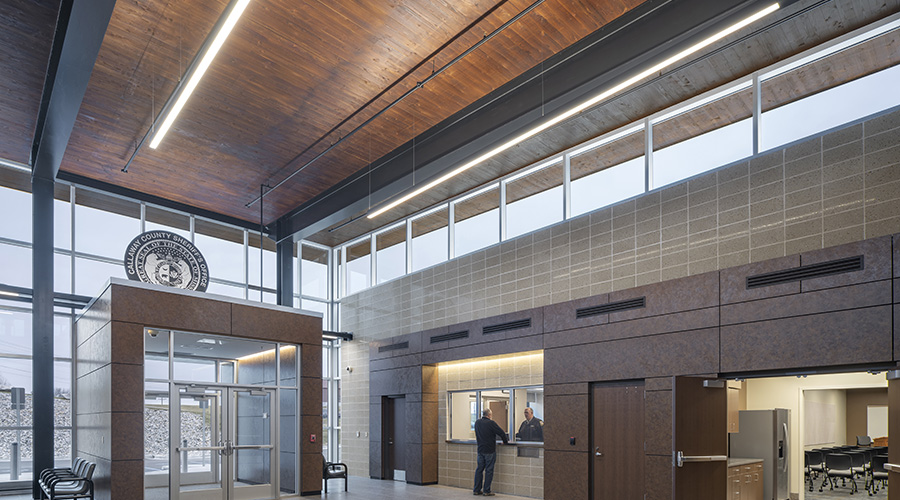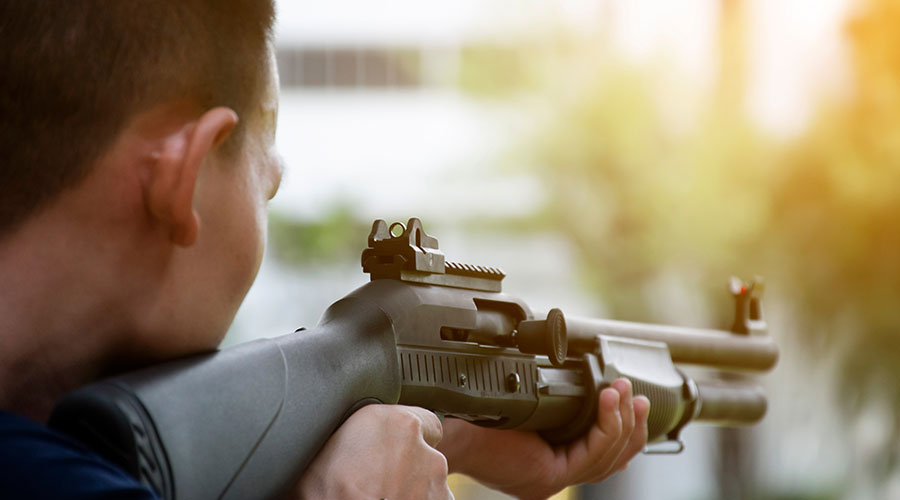What's Next?
With the very real risk that buildings will again be targeted, security experts seek ways to thwart terrorist strikes.
What was it that made the terrorist attacks of Sept. 11 such a surprise?
Perhaps it was the use of airliners as weapons, or the extent of damage caused by those planes-turned-missiles.
Maybe it was because the attacks occurred on symbols of the U.S. economy, Western democracy and American military might.
Or maybe it was that the attackers managed to elude immigration officials, learned how to fly planes in the United States and then slipped past airport security with weapons that allowed them to commandeer the cockpit of four airliners.
Whether it was the loss of life, the raging inferno or the realization that acts of war could take place in New York City and near Washington, D.C., there is one fact that should surprise nobody: Terrorists targeted buildings.
Without dismissing talk that the next terrorist attack could occur at the Golden Gate Bridge, the Statue of Liberty or some other national landmark, the haunting fact is that the next attack has as good a chance as any of occurring at a building.
“If we look historically, buildings have been a popular terrorist target,” says Walter Purdy, director of the Terrorism Research Center, a Fairfax, Va.-based organization.
In addition to the Sept. 11 attacks, other recent, high-profile attacks on facilities jump to mind. There was the 1993 bombing of the World Trade Center that left seven dead and hundreds injured. There was the 1995 bombing of the Alfred P. Murrah Federal Building in Oklahoma City that killed 168 and injured thousands. There were the 1998 bombings of the U.S. Embassies in Nairobi, Kenya, and in Dar es Salaam, Tanzania, that left 224 dead and nearly 5,000 injured.
Then there are a dozen or so attacks on facilities that have been erased, or at least have faded, from memory. Remember in 1983 when alleged Iranian-based suicide bombers crashed a pickup truck full of explosives into the U.S. embassy in Beirut, Lebanon, killing 17 U.S. citizens? Or six months later when members of the same group bombed U.S. Marine barracks in the same city, killing 299? Or how about 1986 when purported Libyan terrorists bombed a West Berlin disco frequented by U.S. soldiers?
Lessons in History
These examples put the most recent attacks in a historical context that will allow facility executives to prepare for the next inevitable attack.
Since Sept. 11, questions have abounded about where the next attack will occur, when it will occur, and what or who will be the target. While there is merit in trying to figure out answers to those questions, the truth is that no facility executive — and no counterterrorism expert — can really know for sure.
By definition, terrorism and terrorist acts are carried out using violent means to achieve a social or political purpose. That doesn’t mean, however, that facility executives need guard only against politically or socially motivated groups. The recent sniper attacks in the Washington, D.C., area had the same effect as terrorist acts: to strike fear in victims far beyond the scope of those under immediate attack. Not knowing when, who or where a terrorist might strike is one of the basic tenets of terrorism.
Nonetheless, both government and private sources have ideas that may help predict what the next act might entail and who is likely to commit it.
“We try to look at it from a terrorist’s point of view and figure out how they might try to attack a building,” says Purdy of the Terrorist Research Center. “It’s almost like reverse engineering.”
The Terrorist Research Center maintains a database of terrorist group profiles. In addition, it has a database indicating weapons each group has used over the past 25 years, weapons they have access to and weapons they would like to acquire.
At the top of the list of likely weapons to be used in a terrorist attack is a chemical or biological agent, such as anthrax, Purdy says. Other likely weapons include any device or means that could inflict widespread damage or harm, such as the distribution of radioactive nuclear material. For facilities, that means air intakes, ducts and ventilation points are prime targets.
Purdy saw first-hand how some facilities in Alexandria, Va., countered the threat to biological weapons. When Zacarias Moussaoui, arrested in connection with the Sept. 11 attacks on charges of conspiracy to commit terrorist acts and use weapons of mass destruction, appeared in a Virginia courtroom, nearby facilities undertook extensive measures to prevent terrorist attacks.
Purdy says corporate and upper-end residential properties installed new 360-degree security cameras, ballistic sheathing on facility exteriors and intrusion detection devices on HVAC intakes, as well as hired law enforcement officials to serve as security guards. Those measures are expected to remain in place — and even be tightened — when Moussaoui’s trial begins in September.
No Single Solution
Rich Maurer, a senior associate with the consulting firm Kroll Schiff and chairman of ASIS International’s Physical Security Council, says it’s important to remember that security threats will vary. Facility executives cannot be lulled into believing that a building’s security system, once in place, is all that’s needed to protect occupants.
Instead, Maurer says, facility executives should review threats and decide whether there is a need to add security personnel or to lock certain doors even just for a day. As an example, he cites the action that McDonald’s and Starbucks owners take when the World Trade Organization meets near their facilities: Based on the likelihood of riots, owners and operators of those facilities board windows to protect the facility and occupants.
One of the problems in protecting and defending facilities during an event like the Moussaoui trial is that every facility in the area is a likely target. Those sympathetic to the accused’s cause could aim to disrupt the trial with a terrorist act, diverting attention from the American justice system and toward their political and social goals.
Darrell Pattison, director of design for the architecture firm KA Inc., says one of the fallouts of the Sept. 11 attacks is that every facility and public infrastructure is a target. Water treatment plants, bridges, shopping malls and national monuments have all taken precautions.
Pulling off successful attacks against such esteemed and protected buildings as the Pentagon and the World Trade Center served to motivate terrorists. Even among domestic terrorists, particularly neo-Nazi groups, the reaction to the Sept. 11 attacks was that it was “a hell of a hit,” says Mark Potok, spokesman for the Southern Poverty Law Center, which tracks domestic terrorist activities.
Potok says domestic terrorist groups applauded the Sept. 11 attack not because it toppled the economic and cultural icons of the World Trade Center towers, but because the attack occurred in “Jew York City.”
“The enemy of our enemy is for now at least our friend,” read an internal memo drafted by the deputy membership coordinator for the National Alliance, a neo-Nazi group the Law Center has identified as having members in 25 states. Potok obtained the memo following the Sept. 11 attacks.
As history shows, terrorists are as likely to continue using old methods of attacking buildings as they are to try new weapons. Purdy of the Terrorist Research Organization says the group’s weapons database shows that pipe bombs, car bombs and package bombs are popular among terrorists.
“Terrorists continue to use the weapons or tools they’re comfortable with and have had success with until you prove you can stop it,” he says.
That fact should take away one more element of surprise from the Sept. 11 attack: It was not the first time hijackers attempted to use a jet to bring a facility down.
Buildings, Again
In 1994, members of the Armed Islamic Group hijacked an airliner in Algiers and killed two passengers during a two-day standoff. After air traffic controllers gave the jet clearance to take off toward France, it landed in Marseille where terrorists ordered the plane to be loaded with 27 tons of jet fuel.
French commandos stormed the plane during refueling, killing the hijackers. During the ensuing investigation, French authorities discovered the terrorist group possessed sketches of the Eiffel Tower exploding.
Buildings are popular targets among terrorists not only because large numbers of people gather in them, but also because people identify with them so strongly. Purdy says to consider the devastation the country would have felt if the Sept. 11 hijackers had been successful in crashing a jet into the Capital Building or White House.
Other countries have learned to live with terrorist threats and have made adjustments to facilities accordingly. While most in this country don’t equate the level of threat in the United States with that in Israel or other Middle East nations, it’s worth looking at some of the things facilities in those nations have done to combat terrorism.
Alon Yitzhaki, a job captain with KA Inc., says the differences between Israeli and American buildings are evident immediately. First, most buildings there are constructed of concrete, which is much more fire resistant than materials used here. Second, the threat of car bombs and suicide bombers has pushed architects to reduce the number of doors and windows. Third, terrorism’s threat prompted changes to a number of operational procedures.
For example, Yitzhaki says, trash bins are bomb proof and garbage is not allowed to accumulate. Also, passenger drop-off areas have been eliminated from facilities. There are no unlit areas. And camera surveillance abounds in and around buildings.
“In Israel, they’ve gotten to the stage where they are willing to put up with a little more intrusion for the greater good of security,” Pattison says.
Even before Sept. 11, some building owners became more sensitive to threats and started making security adjustments. The federal government, for example, instituted a policy after the attack in Oklahoma City requiring 100 feet between a building’s perimeter and the public right of way. Known as “separation,” that concept has been used extensively in federal buildings.
Exactly what changes will occur as a result of Sept. 11 is still unclear. National code organizations are gathering data on the World Trade Center collapse. Once the government’s National Institute of Standards and Technology completes its investigation, some code changes are likely. Even at that, it’s doubtful high-rises will be designed to withstand the force of airliners.
“I don’t know if anybody in their right mind, except for maybe the Pentagon, would build a building with the expense necessary to withstand an airplane going into the side of it,” Pattison says.
The defense facility executives have been using since Sept. 11, and one that is likely to continue, is preparation. Rather than attempting to prevent terrorist attacks — an impossible task at the building level — the focus has been on formulating effective emergency response plans.
“There are so many different ways a terrorist can wreak havoc that it’s impossible to try to design buildings to prevent the next attack,” Pattison says.
Two elements key to any attempt to harden buildings are threat assessments and emergency evacuation and crisis plans. Threat assessments require facility executives to look at physical points where facilities are vulnerable. The assessment should also gather information on just how vulnerable the organization is to a terrorist attack and from what fronts.
Bob Disney, an ASIS International member, says multinational corporations are at more risk than their domestic counterparts, as are companies that engage in animal testing and controversial medical research.
“There are a lot of outfits out there that have causes and will go after companies that violate their causes,” says Disney, who also serves as chairman of the ASIS Global Terrorism and Political Instability Committee.
Practice Makes Perfect
The key to an effective emergency evacuation and crisis management plan is communication. Also, be sure that the plan is up to date and covers different scenarios, everything from fires and terrorist attacks to power outages and chiller pipe breaks.
Disney suggests that facility executives meet regularly — quarterly, for instance — with the building’s security staff to discuss the type of crimes that are occurring in and around a building and to hear tenant concerns. That feedback can then be used to adjust or update a crisis management plan.
“It’s incumbent upon the building manager or owner to make sure a security consultant or director of security is reaching out to every tenant or occupant to communicate crisis plans,” he says.
Not surprisingly, Disney says companies that have spent money on security over the past few years and those that have had effective plans in place are finding it easier to respond to the existing terrorist threat. For example, the World Trade Center evacuation shows even a building that is a known target can benefit from evacuation drills.
Nevertheless, despite the best efforts to improve security and make occupants more familiar with evacuation procedures following the 1983 bombing attack on the World Trade Center, reports from Sept. 11 indicated that some occupants had trouble remembering where staircases were located. Also, Disney suggests keeping and reviewing reports on troubles that occurred during the drill so corrections can be made. Often, drills uncover vacant desks, file cabinets and storage boxes in emergency evacuation stairwells.
“You really need to conduct drills — even full evacuation drills — on a regular basis,” Disney says.
With nearly a year and half gone by since the last terrorist attack, some sense that buildings are again being lulled into a false sense of security. Purdy of the Terrorist Research Center has talked to colleagues in Los Angeles who ask how that “terrorism thing is going” on the East Coast. Pattison of KA Inc. says he still finds coin-operated lockers in public buildings. Yitzhaki, also of KA, says he fears that America’s relative safety from terrorism lulls some building owners into complacency.
“The problem in America is that you need to collapse the Mall of America twice to get them to do anything,” Yitzhaki says.
ASIS International Announces Global Terrorism Conference
Global terrorism is the most urgent issue facing the security industry, and the world, today. In response to the need for security professionals to know more about this threat, ASIS International will be conducting the 21st Annual Government Industry Conference on Global Terrorism & Political Instability March 24-26 in Arlington, Va.
“America’s Infrastructure: The New Battleground” is a two-and-a-half-day program that will examine the breadth and variety of terrorist threats. It will offer insight on how to best respond to the crisis and how the nation can reduce its vulnerabilities. Topics will concentrate on the threat to government and the private sector.
Since 1982, the Annual Government/Industry Conference on Global Terrorism and Political Instability has attracted hundreds of high-level decision-makers from business, government and law enforcement agencies. This year’s conference will examine future terrorist operations and likely changes in tactics and strategy. Experts representing critical U.S. infrastructure will discuss the vulnerabilities of their particular sectors, what this means to the public and private sectors, and what is being done to mitigate the risk.
Industries to be examined include telecommunications, transportation, media, energy, water, defense, banking and finance, agriculture, sporting venues, shopping malls and public health. Other sessions will focus on the recent spate of threats facing the country, including snipers, bombings, anthrax, school violence, cyber attacks, suicide bombers, and chemical and nuclear weapons. Regional updates from the U.S. State Department, Diplomatic Security Service, and Office of Intelligence and Threat Analysis (DS/ITA) also will be presented.
The conference is sponsored by the ASIS Global Terrorism, Political Instability and International Crime Council. For more information.
ASIS International is the pre-eminent international organization for security professionals, with 32,000 members worldwide. Founded in 1955, ASIS is dedicated to increasing the effectiveness and productivity of security professionals by developing educational programs and materials that address broad security interests, such as the ASIS Annual Seminar and Exhibits, as well as specific security topics. ASIS also advocates the role and value of the security management profession to business, the media, government entities and the public. ASIS provides members and the business community with access to a range of programs and services and publishes the industry magazine Security Management.
Related Topics:











